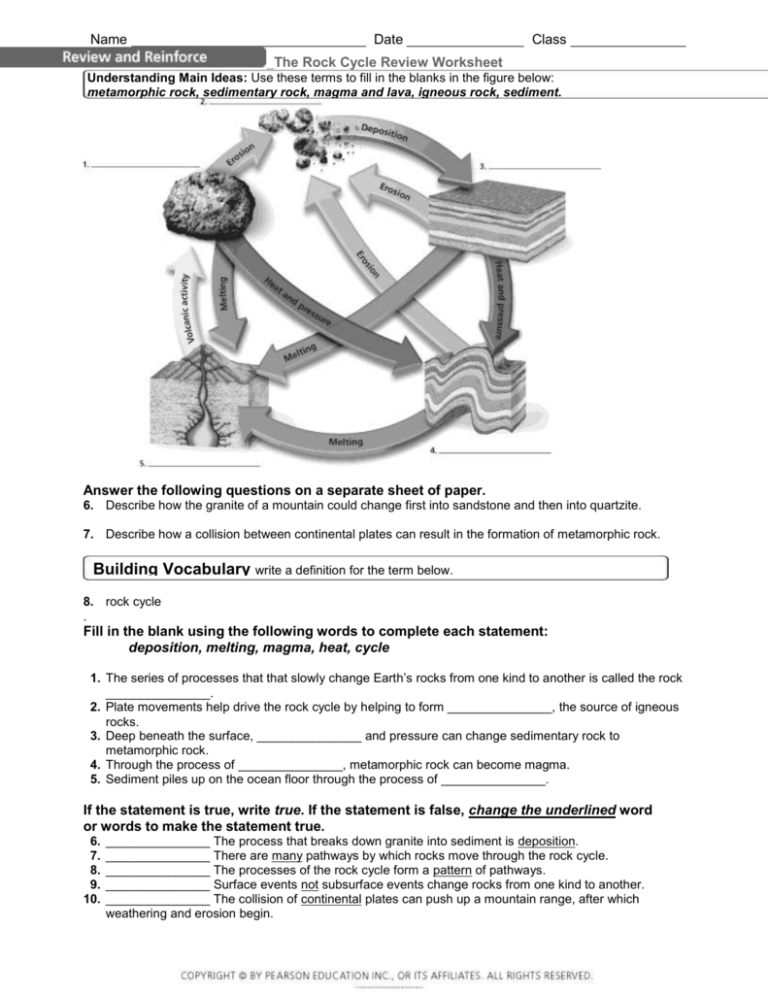Name Date Class The Rock Cycle Review Worksheet Answer the
advertisement

Name Date Class The Rock Cycle Review Worksheet Understanding Main Ideas: Use these terms to fill in the blanks in the figure below: metamorphic rock, sedimentary rock, magma and lava, igneous rock, sediment. Answer the following questions on a separate sheet of paper. 6. Describe how the granite of a mountain could change first into sandstone and then into quartzite. 7. Describe how a collision between continental plates can result in the formation of metamorphic rock. Building Vocabulary write a definition for the term below. 8. rock cycle . Fill in the blank using the following words to complete each statement: deposition, melting, magma, heat, cycle 1. The series of processes that that slowly change Earth’s rocks from one kind to another is called the rock _______________. 2. Plate movements help drive the rock cycle by helping to form _______________, the source of igneous rocks. 3. Deep beneath the surface, _______________ and pressure can change sedimentary rock to metamorphic rock. 4. Through the process of _______________, metamorphic rock can become magma. 5. Sediment piles up on the ocean floor through the process of _______________. If the statement is true, write true. If the statement is false, change the underlined word or words to make the statement true. 6. 7. 8. 9. 10. _______________ The process that breaks down granite into sediment is deposition. _______________ There are many pathways by which rocks move through the rock cycle. _______________ The processes of the rock cycle form a pattern of pathways. _______________ Surface events not subsurface events change rocks from one kind to another. _______________ The collision of continental plates can push up a mountain range, after which weathering and erosion begin. The Rock Cycle Answer Key 1. Each small block in the multicolor cube represents a grain, a particle of a mineral or of another rock. 2. The rock has an easily visible grain. Individual grains (the sides of the small blocks seen on the cube’s faces) are large, and their shape is regular. 7. A collision between continental plates can push rocks down deep beneath the surface. Here, heat and pressure could change the rocks to metamorphic rock. 8. The rock cycle is a series of processes that occur on Earth’s surface and in the crust and mantle that slowly change rocks from one kind to another. 3. The rock is coarse-grained. 4. There is no pattern to the placement of the different grains. They do not form layers, bands of color, or swirling patterns. 1. Only igneous rocks are involved in that pathway. 2. Students’ flowcharts should show igneous rock Through surface events such as deposition, weathering, and erosion, sedimentary rocks are formed from other types of rocks. Subsurface events such as melting, earthquakes, volcanic activity, heat, and pressure change rocks from one type to another. All of these changes are a part of the rock cycle. forming at the mid-ocean ridge, moving across the ocean floor, being subducted at a deepocean trench, melting into mantle material, and becoming igneous rock again. 3. Metamorphic rock changes into sedimentary rock, which changes into metamorphic rock again. 4. Students’ flowcharts should show the formation of metamorphic rock, the erosion of that rock, the formation of sedimentary rock, and the change to metamorphic rock. 1. igneous rock 2. sediment 5. Answers will vary. Students should describe the processes that form the three major groups of rocks. 3. sedimentary rock 4. metamorphic rock 5. magma and lava 6. As the forces of mountain building slowly push the granite upward, weathering and erosion wear away the granite to form sand. Streams carry the sand to the ocean where layers of sediment pile up on the ocean floor. The sediments get compacted and cemented together to form sandstone. If pressure compacts the sandstone particles further and silica replaces the calcite holding the rock together, quartzite will form. 1. cycle 2. magma 3. heat 4. melting 5. deposition 6. weathering 7. true 8. true 9. and 10. true






